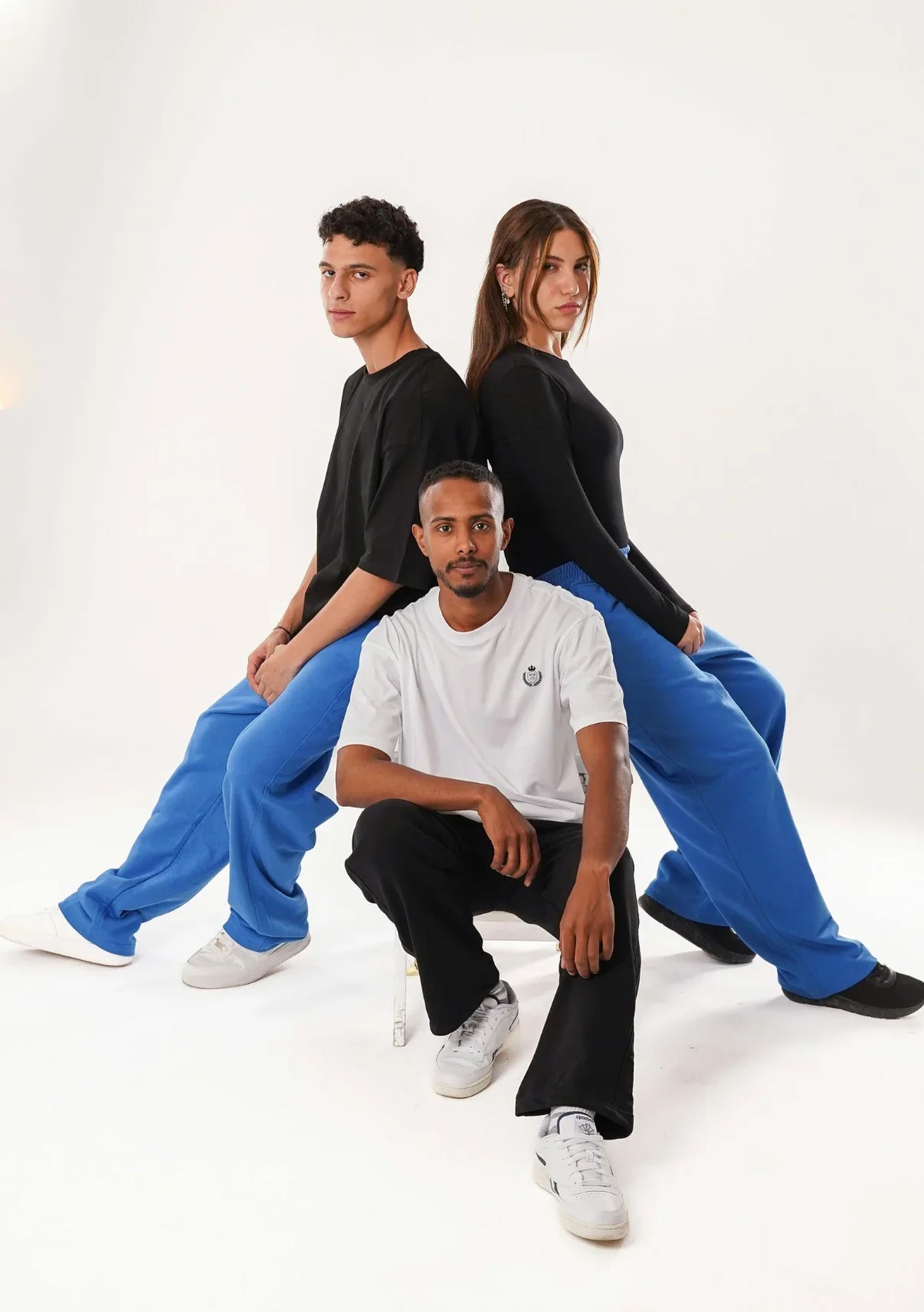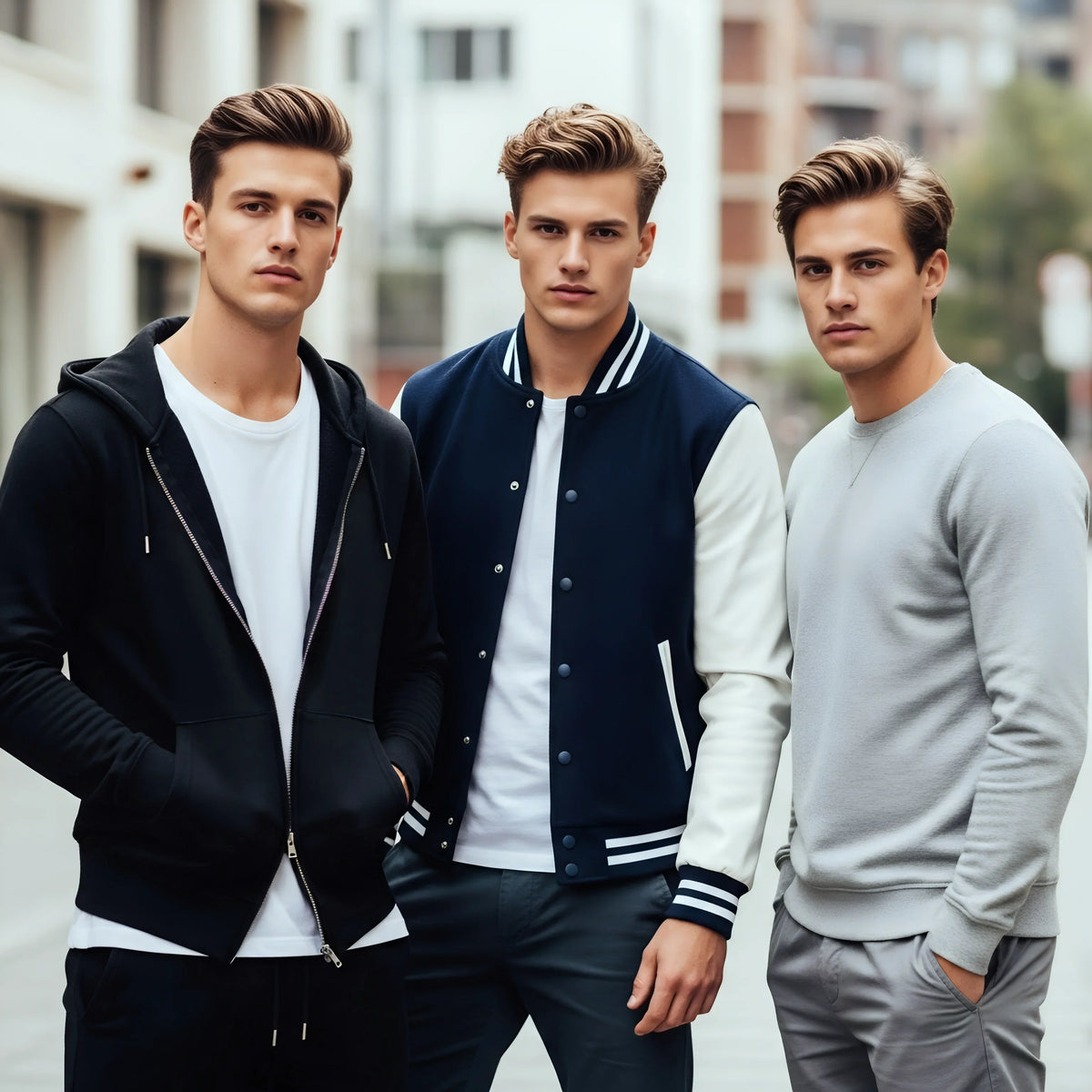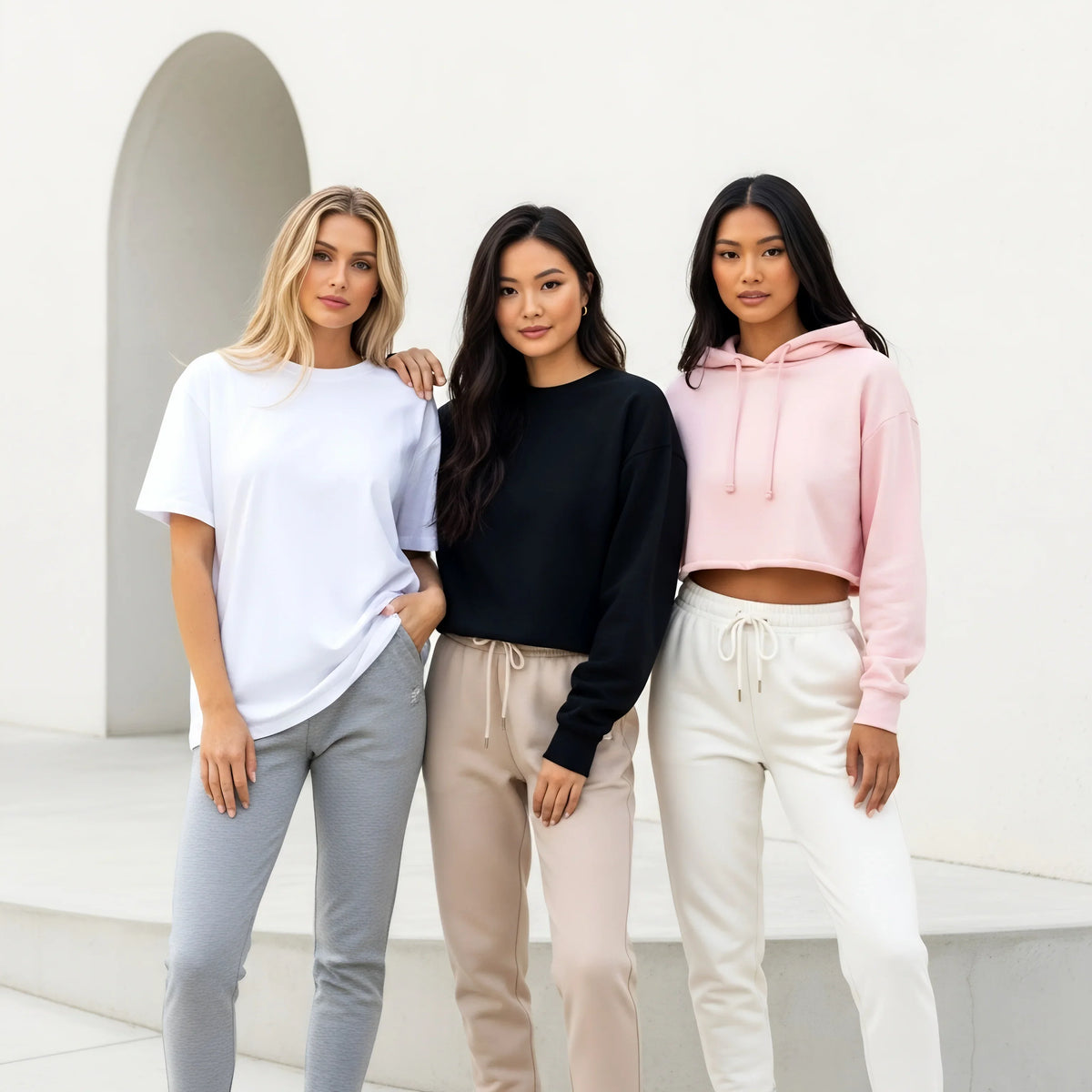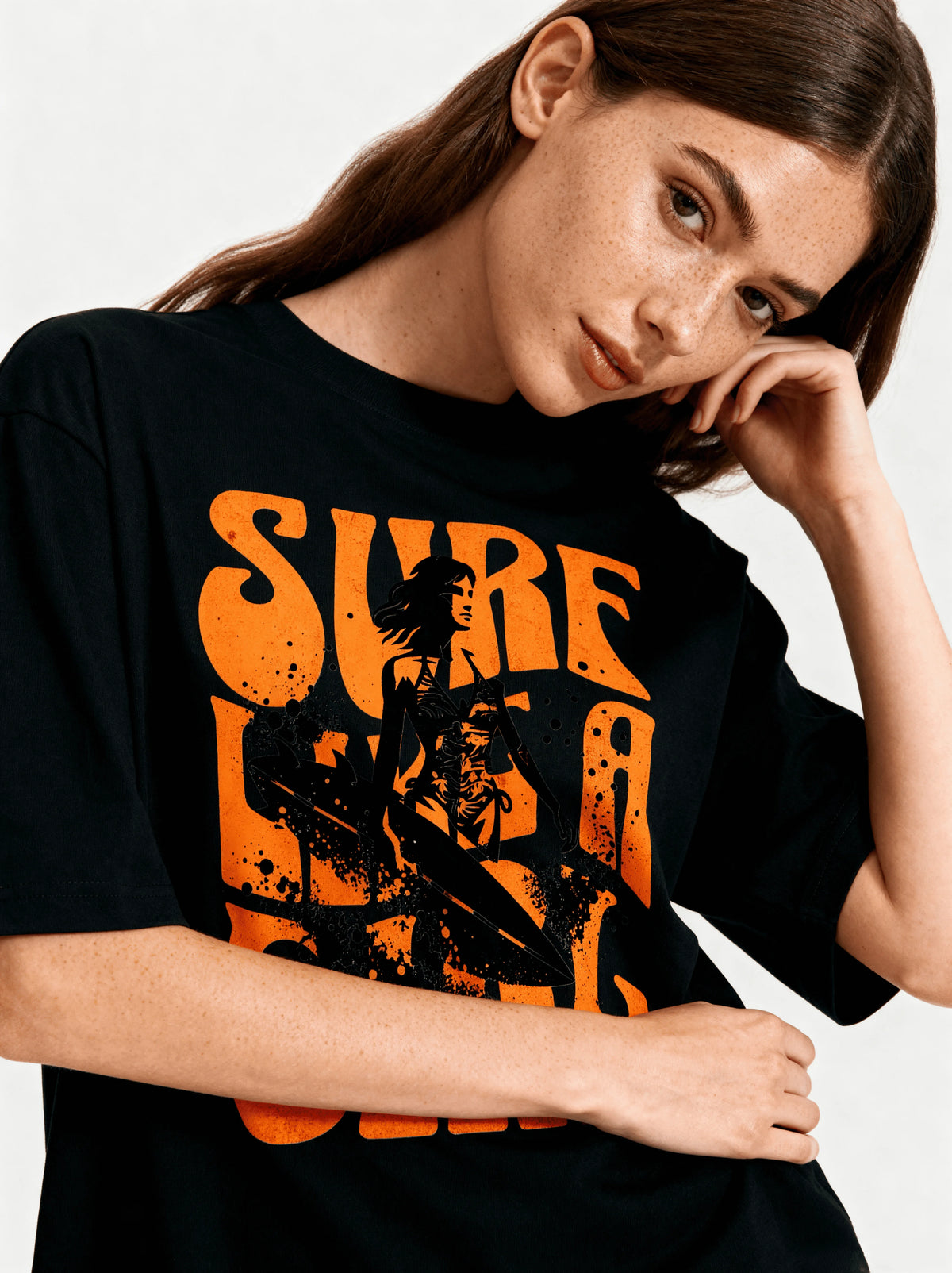You've been there. That perfectly fitted shirt from three years ago now feels restrictive, looks dated, or simply doesn't match how you want to present yourself today. Meanwhile, that loose hoodie you bought around the same time still works with everything in your wardrobe and somehow looks more current than ever.
The oversized versus slim fit debate isn't just about current trends or personal preference. It's about understanding which silhouettes maintain their relevance, adapt to life changes, and continue feeling right years after purchase. When you're investing in quality pieces, longevity matters - not just fabric durability, but style durability.
Most people make the mistake of buying what looks best in the fitting room mirror right now, without considering how that fit will age over the next few years. Body changes, style evolution, trend cycles, and even how we feel about clothing comfort all shift with time. The smartest clothing investments account for these inevitable changes.
This isn't about declaring one fit superior to the other. It's about understanding the lifecycle of different silhouettes so you can build a wardrobe that serves you for years, not just seasons.
Understanding What "Aging Well" Actually Means in Fashion
When we talk about a style "aging well," we're measuring multiple dimensions of longevity. A piece that ages well maintains relevance across several fronts simultaneously.
Visual Timelessness: The Photograph Test
Imagine looking at photos of yourself from five years ago. Some outfits immediately date the image - the proportions, the fit, the styling all scream a specific moment in fashion history. Other looks could have been taken yesterday. This visual timelessness is the first measure of how well a style ages.
Slim fit clothing, particularly in its extreme iterations, tends to timestamp itself. The ultra-tight jeans of the early 2010s, the spray-on tees, the precisely tailored everything - these silhouettes immediately place photos in a specific era. When the pendulum swings toward looser fits, those slim pieces start looking distinctly "from another time."
Oversized fits have historically shown more staying power across trend cycles. While the specific degree of oversizing shifts, the concept of relaxed, comfortable proportions has remained relevant across decades. A well-executed oversized piece from the 1990s can still look intentional today, while a precisely fitted piece from the same era often looks costume-like.
Physical Accommodation: The Body Reality
Here's what fashion magazines rarely discuss: bodies change. Weight fluctuates. Muscle mass shifts. Age affects how we carry ourselves. A style that "ages well" needs to accommodate these natural changes without looking obviously wrong.
Slim fit clothing has minimal tolerance for body changes. Gain five pounds, and suddenly that perfect fit becomes uncomfortable or unflattering. Lose weight, and the garment looks sloppy rather than fitted. The precision that makes slim fit look sharp when it's right also makes it unforgiving when it's slightly off.
Oversized clothing builds in accommodation naturally. A few pounds gained or lost barely registers in how the garment looks and feels. This isn't about hiding the body - it's about creating fits that work across a range of natural fluctuation without requiring wardrobe replacement.
Comfort Evolution: The Lifestyle Shift
How people want to feel in their clothes changes over time. The willingness to tolerate discomfort for aesthetics tends to decrease with age and experience. What felt acceptably fitted at 22 might feel restrictive at 30. What seemed appropriately relaxed at 25 might feel too loose at 35.
Most people find their comfort threshold shifts toward less restriction over time. The tight jeans that seemed fine for a night out become the pair you actively avoid. The fitted blazer that looked professional starts feeling like armor. This evolution favors styles that prioritize comfort alongside aesthetics from the start.
Oversized fits align with this comfort evolution more naturally. They start from a place of physical ease, which means they continue feeling right even as preferences shift. You're less likely to grow out of loving how something feels when it never restricted you in the first place.
The Trend Cycle Reality: How Fashion Movements Affect Longevity
Fashion operates in pendulum swings, and understanding these cycles helps predict which pieces will remain relevant longest.
The Slim Fit Peak and Decline
The 2000s through mid-2010s represented the peak of slim fit dominance. Skinny jeans, fitted tees, tailored everything - the fashion message was clear: tighter meant better. During this period, slim fit pieces felt contemporary, fresh, and modern.
But fashion always rebels against itself. By the late 2010s, the reaction against restrictive fits was building momentum. Comfort became the new luxury, oversized proportions gained credibility, and suddenly those perfectly fitted pieces started looking like artifacts from a passing trend rather than timeless basics.
This doesn't mean slim fit is dead or will never return. Fashion cycles are circular. But it does mean that pieces purchased during the slim fit peak are now visibly dated, while oversized pieces from the same era often still look current.
The Oversized Advantage: Longer Cycles, Softer Swings
Oversized fits move through trend cycles differently. While the specific details shift - the exact degree of oversizing, where volume concentrates, styling conventions - the fundamental concept of relaxed proportions has remained relevant across multiple decades.
Compare a slim fit tee from 2010 with one from 2025. They're likely similar because slim fit has limited variation - it's either fitted or it's not. Now compare an oversized piece from 2010 with one from 2025. They might differ in details, but both remain wearable and current because "oversized" encompasses a range of proportions that can shift without the entire category becoming obsolete.
This wider variance within the category means oversized pieces age more gracefully. They can shift slightly out of the exact current trend while still looking intentional rather than dated.
The Normcore Effect: When Relaxed Becomes Default
The rise of normcore fashion - elevated basics, comfort-forward design, anti-fashion fashion - has fundamentally shifted what reads as "normal" in clothing. Relaxed fits have increasingly become the default, while slim fits have moved toward being a specific choice rather than the baseline.
This shift in what constitutes normal affects how different fits age. When oversized is the default, those pieces blend into any era. When slim fit requires deliberate styling to not look retro, its aging process accelerates.
Body Type Considerations: Which Fit Flatters Longer?
Different body types interact with fit choices in ways that affect long-term satisfaction with clothing purchases.
The Slim Fit Challenge: Precision Requirements
Slim fit looks best within narrow parameters. The body needs to match what the garment expects - specific proportions, certain muscle development, minimal fluctuation. When these align perfectly, slim fit can look excellent. But maintaining that perfect alignment requires consistency most people can't sustain long-term.
For naturally lean builds, slim fit might age better personally even as trends shift. The fit continues working with the body type regardless of fashion cycles. But for most people, the precision required makes slim fit a higher-risk investment for long-term wardrobe staples.
The Oversized Flexibility: Range of Compatibility
Oversized fits work across a wider range of body types and shapes. The key is proportion - the right degree of oversizing for your frame - rather than precision. This flexibility means oversized pieces remain flattering even as bodies change naturally over time.
The common concern about oversized making people look larger is usually about poorly chosen proportions rather than the concept itself. A well-proportioned oversized piece creates visual balance that actually flatters most builds. And because it's not clinging to the body, minor changes don't affect how it looks.
The Athletic Build Evolution
People who work out regularly face a specific challenge: muscle mass changes dramatically affect how slim fit clothing works. Build muscle, and suddenly your fitted shirts are tight in the shoulders and chest. Stop training, and those same pieces become loose and shapeless.
Oversized fits accommodate these changes more gracefully. Added muscle doesn't make the garment uncomfortably tight. Reduced muscle doesn't make it look sloppy. For anyone whose body composition shifts regularly, oversized provides more stable long-term fit.
Fabric and Construction: How Fit Choice Affects Wear Patterns
The way a garment fits affects how it wears over time. This physical aging process compounds with style aging to determine overall longevity.
Stress Points in Slim Fit
Fitted clothing experiences more stress during wear. The fabric stretches with every movement, seams bear more tension, and high-friction areas wear faster. Common stress points include:
- Shoulder seams on fitted tees that gradually weaken
- Thigh areas on slim jeans that thin and tear
- Armpit regions that stretch and distort
- Collar areas that lose shape from constant tension
These stress patterns mean slim fit pieces physically age faster even with quality construction. The fit itself creates wear that wouldn't exist in looser silhouettes.
The Relaxed Wear Advantage
Oversized clothing experiences less mechanical stress during wear. The fabric moves with you rather than stretching against you. Seams remain relaxed rather than strained. This reduced stress means the garment maintains its original structure longer.
This is especially noticeable in heavyweight fabrics. A 300 GSM oversized hoodie drapes naturally and maintains its shape through years of wear. The same weight in a fitted silhouette would stress seams and fabric more intensely, potentially leading to distortion over time.
Premium brands working in heavyweight oversized pieces - you'll see examples from brands building identities around substantial comfort - understand this advantage. The combination of quality fabric and relaxed fit creates genuinely long-lasting garments.
Washing and Recovery
Fitted clothing often struggles to recover its original shape after washing. The constant stress during wear, combined with washing cycles, leads to gradual shape loss. Sleeves stretch, bodies elongate, necklines distort.
Oversized pieces recover more consistently because they weren't stressed during wear. The fabric returns to its relaxed state naturally. This means oversized clothing maintains its intended silhouette longer with standard care.
Styling Versatility: Which Fit Adapts Better Over Time?
A style that ages well needs to work across different styling contexts as your life and preferences evolve.
The Slim Fit Styling Limitation
Slim fit pieces require specific styling to look current. They work best in cohesive, put-together outfits where everything is similarly proportioned. Mix a fitted top with relaxed bottoms and the contrast often looks unintentional rather than styled.
As fashion has moved toward looser proportions, styling slim fit pieces requires more thought and deliberate choices. They can still work, but they need careful integration rather than being automatically versatile.
Oversized as a Styling Foundation
Oversized pieces function as wardrobe building blocks that work across multiple styling approaches. Layer them, wear them alone, mix proportions, contrast with fitted pieces - oversized accommodates various styling directions without fighting you.
This versatility becomes more valuable over time. As your style evolves, as trends shift, as different occasions arise, oversized pieces continue working because they're adaptable foundations rather than specific statements.
The Layering Factor
Oversized fits excel at layering, which becomes increasingly relevant for year-round wardrobes. A relaxed tee works under a hoodie under a jacket without bulk or restriction. Slim fit pieces create cumulative tightness that makes layering uncomfortable or impossible.
As people build more sophisticated wardrobes focused on versatile pieces that work across seasons, the layering advantage of oversized becomes a practical longevity benefit.
The Professional Context Evolution
How different fits work in professional settings has shifted significantly, affecting which pieces maintain relevance as dress codes evolve.
The Formal Fit Tradition
Traditional professional environments favored slim, tailored fits because they read as "dressed up" and intentional. A well-fitted dress shirt and tailored trousers were the default professional uniform.
But professional norms have been shifting, accelerated by remote work and changing generational preferences. Comfort and authenticity are increasingly valued over formal perfection. This evolution affects which pieces continue feeling appropriate in professional contexts.
The Smart Casual Revolution
The rise of smart casual as the new professional standard favors fits that look intentional without being formally restrictive. Well-executed oversized pieces - quality fabrics, clean lines, considered proportions - increasingly read as appropriate professional wear.
A premium oversized tee in heavyweight cotton under a clean blazer can work for many professional contexts now. Five years ago, this would have seemed too casual. This shift means oversized pieces are gaining professional longevity while slim fit pieces are losing some contexts where they once dominated.
The Home Office Reality
Remote work has permanently changed how people think about professional clothing. The need to look presentable on video calls while remaining comfortable during long work days favors clothing that does both.
Oversized fits excel in this hybrid context. They look intentional and put-together on camera while providing all-day comfort off-camera. Slim fit pieces that look sharp for meetings often become uncomfortable for full work days at home.
When Slim Fit Still Makes Sense
Despite the advantages of oversized for long-term wardrobes, slim fit isn't obsolete. Understanding when fitted pieces deserve space helps build balanced, functional wardrobes.
Formal Occasions and Tailoring
True formal wear still benefits from proper fit. Suits, dress shirts for formal events, occasion wear - these contexts still favor tailored proportions. But importantly, these are specialty pieces rather than everyday staples.
The key is recognizing fitted formal wear as occasional-use items rather than wardrobe foundations. They don't need to age through trend cycles the same way because they're not part of daily rotation.
Intentional Styling Moments
Sometimes you want the specific look that slim fit provides. That's legitimate. But approaching fitted pieces as specific styling choices rather than default basics changes how you buy and use them.
If you love how fitted tees look layered under oversized shirts, buy them for that specific purpose. Just recognize they're supporting players in styled outfits rather than standalone versatile pieces.
Athletic and Performance Wear
Activewear often works better in fitted silhouettes for functional reasons. Running shirts that don't flap, gym wear that moves with you during exercise - these contexts favor fit over relaxation.
But even here, the trend toward comfortable athletic wear means many workout pieces are moving toward more relaxed fits. The distinction is narrowing.
Building a Wardrobe That Ages Well: Practical Strategy
Understanding which fits age better informs smarter purchasing decisions for long-term wardrobes.
The 80/20 Foundation Principle
Build your foundational wardrobe - the pieces you wear 80% of the time - around oversized and relaxed fits in quality fabrics. These pieces will remain relevant and comfortable longest. Reserve fitted pieces for the remaining 20% of your wardrobe where specific styling or occasions demand them.
This ratio ensures your core wardrobe ages well while maintaining flexibility for varied styling when desired.
Investment Priorities by Fit
When investing in premium pieces, prioritize oversized options. A ₹3000 heavyweight oversized hoodie will likely serve you for 5+ years and remain stylish throughout. A ₹3000 fitted piece might look dated in 2-3 years despite equal physical durability.
For fitted pieces, consider lower price points since they're higher risk for style obsolescence. Or buy fitted versions of basics you'll replace regularly anyway.
Quality Markers in Oversized Pieces
Since oversized fits are better long-term investments, understanding quality becomes crucial. Look for:
- Heavyweight fabrics (260+ GSM) that provide structure despite relaxed fit
- Proper proportioning - oversized shouldn't mean shapeless
- Quality construction that maintains intended drape
- Pre-shrunk, bio-washed fabrics that maintain consistency
Brands like CozyVora that focus on heavyweight oversized pieces with super-combed cotton understand this quality equation. When you find brands combining substantial fabrics with relaxed fits and proper construction, you've found long-term wardrobe solutions.
The Try-Before-You-Invest Test
Before committing to expensive oversized pieces, try the fit category in lower-cost options. Make sure you're comfortable with the proportions and styling. Once you confirm oversized works for your lifestyle, invest in quality versions that will last years.
The Sustainability Angle: Longevity as Environmental Choice
The fit that ages better is also the more sustainable choice, which increasingly matters to conscious consumers.
Replacement Frequency Impact
Clothing that remains relevant and flattering longer means less frequent replacement. If oversized pieces last 5 years while slim fit pieces feel dated in 3, that's a 40% reduction in consumption for the same wardrobe function.
This reduced replacement frequency compounds with physical durability to create genuinely sustainable wardrobes.
The True Cost Calculation
When evaluating cost, factor in longevity:
A ₹1500 oversized tee that remains relevant for 5 years costs ₹300 per year of use. A ₹800 slim fit tee that feels dated in 2 years costs ₹400 per year, despite lower initial price.
This calculation makes oversized pieces in quality fabrics often more economical despite higher upfront costs.
Emotional Sustainability
There's psychological waste in clothes you stop wearing because they feel wrong even though they're physically intact. Oversized pieces that continue feeling right reduce this emotional obsolescence.
When clothing continues serving you emotionally and practically for years, you've achieved true sustainability - not just environmentally, but personally.
The Future of Fit: Where Fashion Is Heading
Understanding where fit preferences are trending helps predict which pieces will age best when purchased today.
Comfort as Permanent Shift
The movement toward comfort-forward fashion isn't a temporary trend - it represents a fundamental value shift. Post-pandemic priorities, wellness consciousness, and rejection of performative discomfort all point toward relaxed fits remaining relevant long-term.
This doesn't mean slim fit disappears, but it does mean oversized and relaxed proportions have moved from trend to viable default. Pieces purchased with this understanding will age better than those betting on a return to slim fit dominance.
Technical Comfort Innovation
Fashion innovation is increasingly focused on making comfortable pieces look refined rather than making restrictive pieces more comfortable. Heavyweight oversized hoodies in premium fabrics, elevated joggers, substantial tees - these categories are getting more investment and development.
This innovation focus suggests the market believes in long-term relevance for comfort-forward styles, which supports their longevity as wardrobe investments.
The Gen Z Influence
Younger consumers show strong preference for oversized, comfortable proportions. As this generation's preferences become dominant, the style landscape will reflect their values. Buying oversized pieces today means buying into the aesthetic that's becoming standard.
Making Your Choice: Personal Fit Strategy
Ultimately, the question isn't which fit is objectively better, but which serves your specific needs and lifestyle longest.
Know Your Priority Hierarchy
Rank what matters most in your wardrobe:
- Physical comfort during wear
- Professional appropriateness
- Trend relevance
- Style versatility
- Body change accommodation
- Styling flexibility
Your ranking determines which fit biases make sense for you. If trend relevance ranks low and professional formality ranks high, fitted pieces might work longer for you. If comfort and versatility lead your priorities, oversized serves better.
Audit Your Current Wardrobe
Look at what you actually wear repeatedly versus what sits unused. Often, the most-worn pieces share fit characteristics that work for your lifestyle. If your favorite items trend oversized, that signals where to invest going forward.
Consider Your Life Stage
Different life stages favor different fits:
Early Career (20s): Experimentation room exists. Try various fits, but invest primarily in versatile oversized pieces.
Established Professional (30s-40s): Refined comfort matters. Quality oversized pieces in premium fabrics serve multiple contexts.
Later Years (50+): Comfort and ease become priorities. Oversized pieces that look intentional without restriction make sense.
These aren't rules - they're patterns that help inform personal strategy.
The Verdict: Which Style Actually Ages Better?
Based on trend longevity, physical accommodation, comfort evolution, and styling versatility, oversized fits demonstrably age better than slim fits for most people in most contexts.
This doesn't make slim fit wrong or obsolete. It means that when building a long-term wardrobe focused on pieces that remain relevant and satisfying for years, oversized provides better odds of lasting satisfaction.
The best wardrobes include both - oversized pieces forming the reliable foundation, fitted pieces adding styling options when desired. But the investment priority, the quality focus, and the bulk of your wardrobe budget should favor fits that age well across multiple dimensions.
When you understand which styles maintain relevance longest, you stop chasing trends and start building wardrobes that genuinely serve you for years. That's the real measure of style that ages well - not whether it's currently trendy, but whether it continues feeling right long after purchase.
Ready to Build a Wardrobe That Ages Better?
Focus on quality oversized pieces in heavyweight fabrics with proper construction. Look for brands transparent about materials, specific about GSM weights, and committed to fits that prioritize comfort without sacrificing style.
Brands like CozyVora demonstrate what's possible when oversized fits meet quality fabric - substantial comfort that looks intentional, pieces that work across contexts, and construction that ensures years of wear. When you find brands taking this approach seriously, you've found wardrobe investments that truly age well.
Comfort Embraces Elegance






